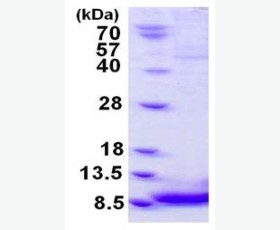Recombinant Human Carbonic Anhydrase 14/CA14
| Product name: | Recombinant Human Carbonic Anhydrase 14/CA14 |
| Source: | E. coli |
| Purity: | Greater than 95% as determined by reducing SDS-PAGE. |
| Buffer Formulation: | Supplied as a 0.2 μm filtered solution of 20mM Tris, 150mM NaCl, 10% Glycerol, pH 8.0. |
| Applications: | Applications:SDS-PAGE; WB; ELISA; IP. |
| Storage: | Avoid repeated freeze/thaw cycles. Store at 2-8 oC for one month. Aliquot and store at -80 oC for 12 months. |
| UOM: | 100ug/50ug/200ug/1mg/1g |
| Source | E. coli |
| Description | Recombinant Human Carbonic Anhydrase 14 is produced by our E.coli expression system and the target gene encoding Gly19-Met290 is expressed with a 6His tag at the N-terminus. |
| Names | Carbonic Anhydrase 14, Carbonate Dehydratase XIV, Carbonic Anhydrase XIV, CA-XIV, CA14, UNQ690/PRO1335 |
| Accession # | Q9ULX7 |
| Formulation | Supplied as a 0.2 μm filtered solution of 20mM Tris, 150mM NaCl, 10% Glycerol, pH 8.0. |
| Shipping |
The product is shipped on dry ice/ice packs. |
| Storage |
Store at < -20°C, stable for 6 months after receipt. Please minimize freeze-thaw cycles. |
| Purity |
Greater than 95% as determined by reducing SDS-PAGE. |
| Endotoxin | Less than 0.1 ng/µg (1 IEU/µg) as determined by LAL test. |
| Amino Acid Sequence |
MNHKVHHHHHHMGQHWTYEGPHGQDHWPASYPECGNNAQSPIDIQTDSVTFDPDLPALQPHGYDQ PGTEPLDLHNNGHTVQLSLPSTLYLGGLPRKYVAAQLHLHWGQKGSPGGSEHQINSEATFAELHI VHYDSDSYDSLSEAAERPQGLAVLGILIEVGETKNIAYEHILSHLHEVRHKDQKTSVPPFNLREL LPKQLGQYFRYNGSLTTPPCYQSVLWTVFYRRSQISMEQLEKLQGTLFSTEEEPSKLLVQNYRAL QPLNQRMVFASFIQAGSSYTTGEMVDLQSR
|
| Background | Carbonic Anhydrase 14 (CA14) belongs to the Alpha-Carbonic Anhydrase family. It is highly expressed in all parts of the central nervous system and lowly expressed in adult liver, heart, small intestine, colon, kidney, urinary bladder, and skeletal muscle. CA14 along with other Carbonic Anhydrases (CAs) participate in a variety of biological processes, including respiration, calcification, acid-base balance, bone resorption, and the formation of aqueous humor, cerebrospinal fluid, saliva, and gastric acid. CA14 is predicted to be a type I membrane protein and catalyzes the reversible hydration of carbon dioxide. |














